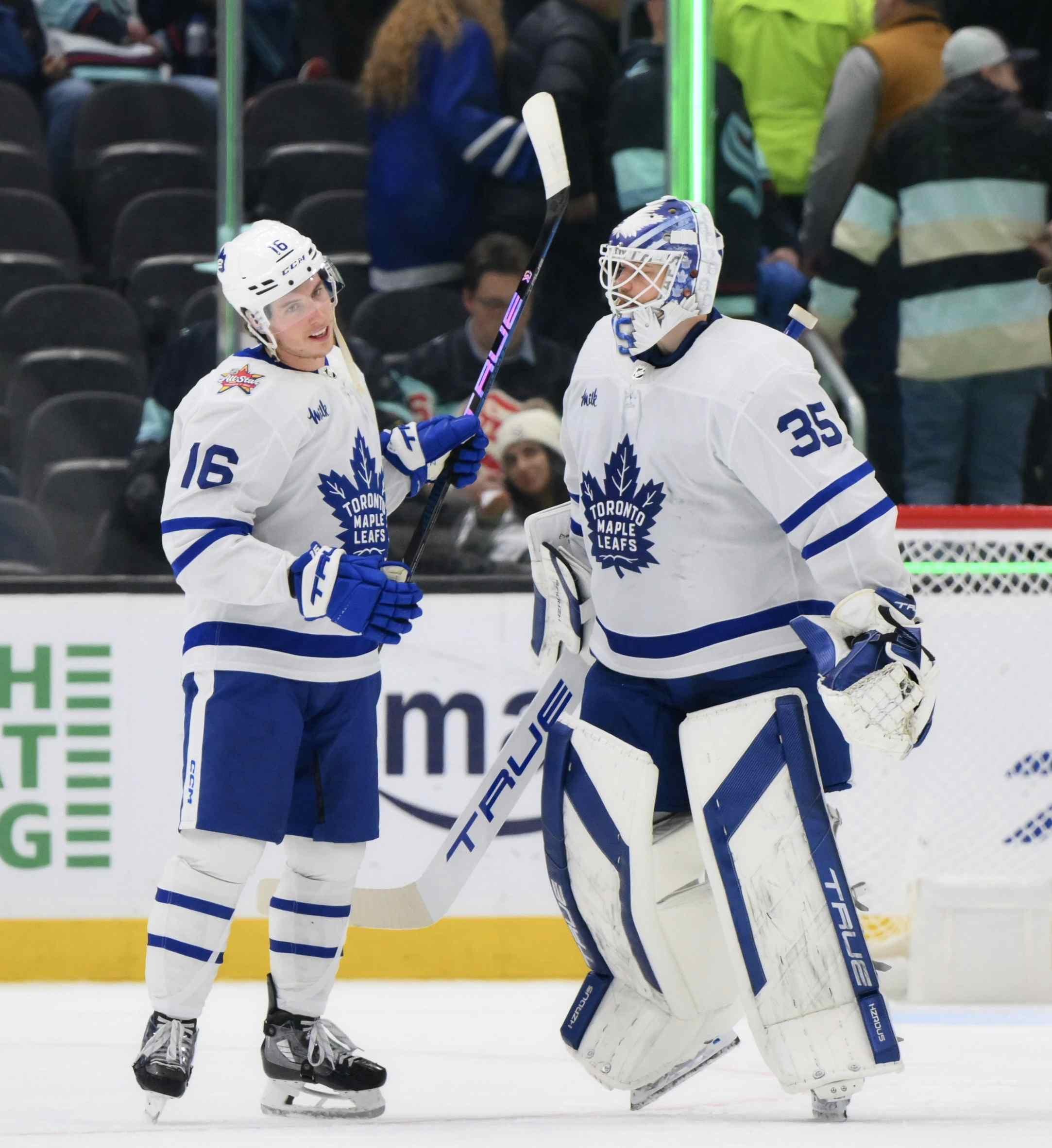Game One Thoughts: How the Leafs shut down the Bruins top line

By Nick DeSouza
5 years ago One of the main storylines going into the playoffs this year was whether the Leafs would be able to shut down the best line in the league. After the signing of John Tavares and the trade for Jake Muzzin, the Leafs seemed a lot more equipped for the task and their Game One performance only solidified that notion.
I was a bit surprised that Babcock went with the Muzzin-Zaitsev pairing but it paid off in a big way, as the Bruins top line was silenced in a 4-1 win for the Leafs. But of course, it takes five players to defend and the line of Hyman, Tavares, and Marner also deserve a lot of credit for what happened last night.
Therefore this piece will showcase what the five-man unit of Zach Hyman, John Tavares, Mitch Marner, Jake Muzzin and Nikita Zaitsev did to shut down the Bruins top line.
Simple breakouts can be beautiful
This season, one of the most controversial topics in the land of #LeafsNation was the Leafs breakouts. Last year, the Bruins exploited this and were able to take advantage an obvious weakness of the Leafs right defencemen: their inability to move the puck.
I made a six-minute video showing some examples of this and how the Leafs can overcome it this year.
Failed to load video.
Throughout this season, I have heavily criticized Mike Babcock on his overreliance of the stretch pass. During these sequences, the Leafs forwards leave the zone early, and the defenceman has no choice but make a long pass. More times than not, the opposing team gets the puck back. Here’s an example of it at it’s worst.
Last night, this strategy worked well when the first lines of each team were against each other.
Historically, the Bruins top line is very good at winning the puck back in the offensive zone. To counter this, the Leafs didn’t risk giving the puck away by looking for a clean pass. Instead, they cleared it out and used their speed to retrieve the puck.
Below, the Bruins are going to lose the faceoff and prepare to win the puck back. Rather than looking for a clean outlet pass, Marner instinctively flips the puck onto the side occupied by Hyman and Chara. It’s a simple play, but Hyman’s ability to puck-hunt, mixed with Chara’s lack of mobility allows the Leafs to win the puck back.
Here we see Johnsson use a similar strategy to avoid Bergeron’s relentless pursuit.
The speed of the Leafs was causing problems for the Bruins all night. Below, Rielly engages physically and separates Marchand from the puck. Kadri flips the puck out, and Chara is forced to take an interference penalty on the speedy Kapanen.
Here’s an example of the Leafs using their speed to create zone exits. Johnsson sees open ice and skates past Marchand in the neutral zone.
Clogging up the neutral zone
It sounds cliche but the line of Marner, Tavares, and Hyman always seem to be in the right place. They are active without the puck and can create turnovers in all three zones. Last night, they were making life extremely difficult for the Bruins top line in the neutral zone.
One of the most intriguing ongoing battles in this series will be between Patrice Bergeron and John Tavares. Here, we see Tavares all over Bergeron as he looks to receive a pass. He then simply puts the puck into a pocket of space, knowing that Marner will beat Chara in that race.
Forcing turnovers in the offensive zone
One of the best ways to keep the Bergeron line from scoring is by making them spend time in their own end. Hyman, Tavares, and Marner have been forcing turnovers in the offensive zone all season, and last night was no exception.
It also helps when you can create scoring chances in the offensive zone.
Taking away opportunities from the slot
The Bruins first line does a great job winning battles along the boards, especially in the offensive zone. Once they win that battle, they have another forward who is ready in the slot, waiting for a pass.
We saw an example of this last year in Game 1. Bergeron and Marchand’s domination along the boards leads to two chances for Pastrnak from the slot. Plekanec is not tight enough on Pastrnak and allows him to get open twice in a span of ten seconds. As a result, the Leafs pay for it.
We saw a similar sequence last night. Marchand wins the initial race, Pastrnak is ready for the cycle and Bergeron creeps into the slot. This time though, Marner checks his shoulder, sees Bergeron coming and deflects the pass away. In addition, Tavares is within reach of Bergeron to make sure he doesn’t receive the pass.
Here’s another example, but on the rush. Gardiner does well to not only push Pastrnak to the outside but to limit his space as well. Tavares and Hyman fill-in to make sure there’s no way Bergeron receives the pass.
Watching the cross-ice pass
This top line’s domination on the perimeter of the rink also opens up cross-ice passes that they score on quite often. The Leafs have seen this many times in the past year. Here’s an example of it from their game earlier in the season.
As the Leafs watch Bergeron skate on the perimeter of the ice, Pastrnak gets cozy in the pocket and waits for the incoming pass.
Last night, the Leafs stopped this in two specific ways.
- Their pressure on the player along the boards was unrelenting all night. In the past, the Leafs have been content with keeping the Bruins forward to the outside and hovering beside them. Last night, they were looking to close down space and engage physically.
- The Leafs’ weak-side winger and defenceman did a good job marking the back-door forward to make sure they weren’t open for a pass.
Here we see Pastrnak get open on the strong-side off the faceoff. Hyman quickly makes his way over to pressure him. On the other side of the ice, Muzzin actively steps up into the passing lane just in case a pass is made to Marchand.
Here the Leafs are very aggressive on the Bruins forwards as they work the puck along the boards. Muzzin and Zaitsev are very good at breaking up the cycle and this could be a major reason why they were appointed with the task of shutting down the Bergeron line.
Where the Leafs could be in trouble
Breakouts weren’t a huge issue for the Leafs in Game One, but it could become one as the series goes on. It’s no secret that Zaitsev has trouble moving the puck and it was apparent early on last night.
In comparison, Jake Muzzin is better but doesn’t usually thrive as the primary puck-mover in his pairing. He doesn’t have a skill-set that allows him to make high-end plays under pressure.
Here’s an example of Muzzin trying to evade Pastrnak. It results in Muzzin falling, and a partial-chance for the Bruins.
Final Thoughts
- The series is far from over but a Game One win on the road was huge. The Leafs have stolen home-ice advantage and Babcock will be able to get the matchups he wants in Toronto.
- Muzzin and Zaitsev are clearly the best option to shut down the Bergeron line. The Leafs need to continue finding ways to mask their puck-moving weaknesses.
- The Leafs should continue targeting Zdeno Chara. In terms of mobility, he is the clear weak link of the Mcavoy-Chara pairing and the Leafs have speedy wingers that can expose this.
- The Gardiner-Dermott pairing got outplayed at even strength last night. I don’t expect this to happen in Game Two and it’s tough to break up the other two pairings at this point. Hopefully, this was just an outlier.
- I hope the Leafs double down on their speed game. We saw some shifts where Nylander and Kapanen switched spots and I would love to see Moore promoted to the third line when they do that switch. A line of Moore, Kadri, and Kapanen could give the Bruins an immense amount of trouble.
- In conclusion, I expect the Bruins to be a lot tighter in Game Two. They made a lot of uncharacteristic mistakes and the Leafs took advantage. Going forward, the Leafs shouldn’t expect to continue scoring two breakaway goals per game against the Bruins. It looks like we are in for an awesome series.
Thanks for reading.
Recent articles from Nick DeSouza





